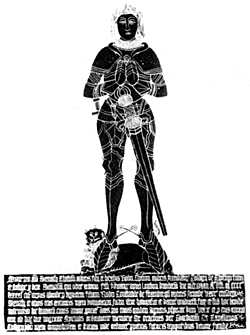
Gervase Clifton, Clifton (1491).
SIR GERVASE CLIFTON. 1491.
CHURCH OF ST. MARY, CLIFTON.
The brass of Sir Gervase Clifton is a good example of the early Tudor brasses, as he died in 1491.
The knight is clad in a mail collar, pauldrons, and cuirass. The cuirass is strengthened by placcates buckled on the centre. His coudieres are small compared with other examples of about this date, such as the Wollaton brass of 1471. He has a taces of three lames, from which hang two rather large tuiles. His cuisses, genouillieres, and jambes are normal, and his sollerets pointed, with long rowel spurs attached. His sword is suspended diagonally, and he has the usual misericorde. He has a lion at his feet.
The figure is 35½in. in length.
INSCRIPTION.
“Orate pro aia Gervasii Clyfton militis filii et heredis Robti Clyfton militis ffundator collegii de Clyfton finiti / et stabilit p doni Gervasiu qui obiit in domo fratrum p’dicator apud london duodecimi die mese maii Ao. dni M°CCCC / lxxxxi cui corpus abinde p Agnetam filiain Rob’ti Constable de fflamburgh militis secunde uxor ejusdem / Gervasii et alios ejus executores juxta voluntatem suam istut honorifice et decent conductu fuit et sub hoc lapide / marmoreo hic humatu cuius anime ppiciet deus pro cuius quidem Agnetis pspitate dum vixit et p’ejus anima / cum ab hac luce migravit Speciales ordinantur memorie et oraciones per Gardianum et Capellanos / collegii pdci juxta composicoem et statuta inde ordinat ppetuis futuris temporibus devote fiende.”
TRANSLATION.
“Pray for the soul of Gervase Clyfton Knight son and heir of Robert Clyfton Knight founder of the college of Clyfton completed and firmly established by Sir Gervase who died in the house of the friar preachers in London on May 12th A.D. 1491 whose body by Agnes daughter of Robert Constable of Flamburgh Knight and second wife of the same Gervase and by his other executors according to his wishes was brought hither with honour and seemliness and interred beneath this marble stone here on whose soul may God have mercy; for the prosperity of this Agnes while she lived and for her soul when she departed from this world special memorials and prayers are established to be offered by the Warden and Chaplains of the aforesaid college according to the deed and statutes there laid down as to be faithfully carried out in all future time.”
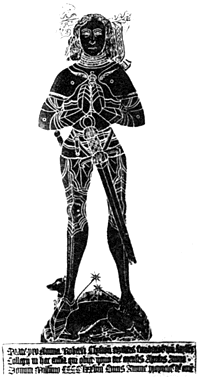
Robert Clifton, Clifton (1478).
SIR ROBERT CLIFTON. 1478.
CHURCH OF ST MARY, CLIFTON.
The armour in which Sir Robert Clifton is shewn is almost the same as that in which Sir Gervase is depicted in 1491. In this case, however, the sword grip is ornamented, and the figure stands on a greyhound. Probably a crest and lambrequin at one time adorned the figure, as the remains are yet to be seen. The increase in shading should be noted.
The figure is 35in. in height.
Sir Robert died in 1478.
INSCRIPTION (Black letter).
“Orate pro anima Roberti Clyfton militis fundator trill capplor collegii in hac ecclia qui obiit nono die mensis Aprilis anno domini millimo CCCClxxviii cuius anime propiciet de amë.”
TRANSLATION.
“Pray for the soul of Robert Clifton Knight founder of a College for three chantry priests in this church who died the ninth day of the month of April in the year of the Lord 1478 on whose soul may God have mercy.”
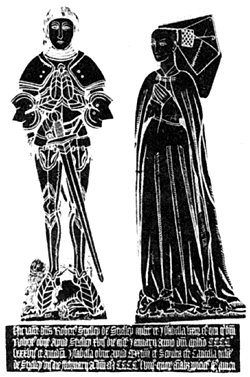
Sir Robert Strelley and Lady (1487 and 1458).
SIR ROBERT STRELLEY AND LADY. 1487 and 1458.
CHURCH OF ST. MARTIN, STRELLEY.
The male figure is much the same as that of Sir Gervase Clifton, except that the coudieres or elbow guards are of the exaggerated pattern found in many brasses of this time. These coudieres were apparently a question of fashion, and probably more ornamental than useful, as they must have been very much in the way in warfare.
In this example, the mail petticoat appears beneath the taces.
The lady is shewn with the butterfly head-dress, with her hair combed back and put into a richly ornamented cap, over which a veil of fine material is kept in its position by supporting wires. Her dress is a tight fitting gown, with mittens over the hands. Her flowing mantle is fastened at the neck by an arrangement of cords. At her feet are two pet dogs, one smooth-coated and one shaggy.
In addition to the figures there is a helmet and mantling, and portion of the crest. There is also one of the original eighteen stars, and the matrices of the plates which represented the children.
I am indebted to Mr. Edge’s paper on Strelley Church for some of this information.
The figures are 28¼4in. and 26½in. in height respectively.
The knight died at Strelley in 1487, and his lady at Oxton in 1458. Both were buried in the chancel of Strelley Church.
INSCRIPTION.
“Hic jacet dns Robert Strelley de Strelley milit et Issabella uxor ei’ qui q’dm / Robert obiit apud Strelley XVII° die mes Januarii anno diii millio CCCC° / lxxxvii et antedca Issabella obiit apud Oxton et sepulta de Cancella ecclie / de Strelley VII die ffebruarii A° dni mcccclviiio quor aiabs ppiciet de’ Amen.”
TRANSLATION.
“Here lies Sir Robert Strelley of Strelley, Knight, and Isabella his wife, which said Robert died at Strelley the 17th day of January in the year of the Lord 1487; and the aforesaid Isabella died at Oxton, and was buried in the chancel of the church at Strelley, the 7th of February, in the year of the Lord 1458. On whose souls may God have mercy. Amen.”
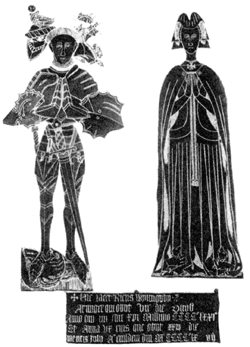
Richard Willoughby and wife, Wollaton (1467 and 1471).
RICHARD WILLOUGHBY AND WIFE. 1467 and 1471.
CHURCH OF ST. LEONARD, WOLLATON.
Beneath a canopy, on a Purbeck marble slab in the chancel of St. Leonard’s Church, Wollaton, is a brass in memory of Richard Willoughby and his wife. This is the earliest military brass in the county. He died in 1471.
The figure shews the squire clad in full defensive armour of the best period, and the brass is finely engraved. It is 36in. in height.
His head rests on his helmet with the visor raised, and the Willoughby crest, richly mantled with oak leaves, is also shewn.
His hair, as usual in Yorkist brasses, is closely cropped. Round his neck is the standard of mail. On his left shoulder he wears a pauldron of five ridges, and on his right an epauliere of five plates, with an oblong palette over right arm-pit. His coudieres are enormous, that on the left being the larger. His gauntiets of steel have finger plates which completely cover the fingers. On his body is the cuirass, to which is attached a taces of five lames, with two tuiles to cover the thighs, buckled to the bottom lames. On his legs are cuisses, genouillières with additional plates pointed beneath, and jambes, while on his feet are long, pointed sollerets. A plain, short hilted sword and misericorde complete his arms. He is shewn standing on a whelk-shaped shell, the badge of the family. There are others on the slab.
The lady is shewn with the horned or mitred headdress, then disappearing. The veil only reaches to the neck. She wears a sideless côte hardie. Over all a long, flowing mantle. A gold chain, from which is suspended a jewelled cross, hangs round her neck. Two small belied dogs are playing at her feet. The lady died four years before her husband. The figure is 34in. in height.
The inscription round the chamfered edge of the tomb records the dates of their deaths, and Thoroton gives some additional words now missing.
Mr. George Fellows gives a very interesting account of this brass in his book on Wollaton.
Three shields appear above the figures.
INSCRIPTION.
“Hic jacet Ricus Willughby
Armiger qui obiit VII die Octob anno
domini Jhu XVI Millimo CCCC°LXXI et
Anna ux ejus que obiit XXIII die
mensis Julii A° ejusdem dni M°CCCC°LXVII.”
TRANSLATION.
“Here lies Richard Willoughby Esquire who died the 7th of October in the year of our Lord Jesus Christ 1471 and Anna his wife who died July 23rd in the year of the same Lord 1467.”
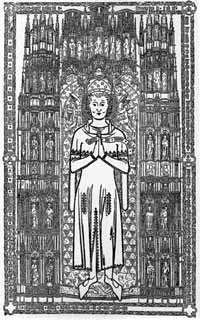
Alan Fleming, Newark (c.1363).
ALAN FLEMING. 1363
CHURCH. OF ST. MARY MAGDALENE, NEWARK-ON-TRENT.
This very fine brass commemorates Alan Fleming, of Newark-on-Trent, who died in 1363. It is undoubtedly one of the finest brasses in England, as well as being one of the largest, and is one of the four large Flemish brasses now in England. The others are at Kings Lynn, where there are two, and at St. Albans Abbey, where there is one. These brasses are all very much alike in composition; each has a large central figure under a canopy. At the top is a representation of the Deity enthroned, and smaller figures are disposed down the sides. All were evidently engraved by one artist.
A Flemish brass was sold from Kings Lynn Church by the churchwardens, in the year 1800, for the sum of five shillings. From the rightly jealous way in which the churchwardens of Newark Parish Church watched us while we rubbed their Fleming brass, I do not anticipate that anything of a similar kind will happen at Newark.
The Newark brass measures 9ft. 4½ by 5ft. 7¾in., and is composed of sixteen plates of metal arranged in three vertical sets; five plates to the outside sets, and six to the middle set. Each plate is about fin. thick, and all are fastened to sheets of iron about 1/8in. thick. The plates are of the following sizes: on the left hand side, 21¼in., 17in., 25¾in., 21¼in., and 26¼in. deep; the middle set are 18in., 19¾in., 20¾in., 19½in., 21in., and 12½in. deep; the right hand set are 8½in., 27in., 27½in., 19¼in., 29¼in. deep respectively. The two outside rows of plates are each 21in. in width, while the middle row is 25¼in. in width. The late Mr. Cornelius Brown quotes a statement to the effect that each plate is about 30in. in length; this, however, is incorrect, as the above figures shew. The top of the brass is 16ft. from the floor.
A framed notice under the brass reads :—
“The original position was on the floor of the South Transept, the Chapel of the S. Trinity, affixed to a large stone now in the centre alley of the nave itself. Supposed to be a Flemish work; it was removed from the floor in 1823 and affixed behind the Reredos, but was brought back to South Transept wall in 1853.”
The late Mr. Cornelius Brown, in his History of Newark, quotes the following description of the brass:—
“The deceased is represented in a Civilian’s habit of the time—a long tunic with strait sleeves, having lappets lined with fur, and a cape covering the shoulders. The hands are conjoined in prayer, and a scroll upon his breast has these words ‘Miserere mei Domine Deus meus.’ At his feet is a lion seizing upon a hairy human figure; it is perhaps allegorical—’ the roaring lion seeking whom he may devour,’ The figure is under a rich and ornate triple canopy, surmounted with tabernacle work, containing representations of ‘Abraham’s bosom,’ the soul of deceased in a winding sheet, and on one side a figure of St. Peter, who points significantly to the keys of heaven and hell which he holds. The figure on the other side is that of a female saint. The background of the effigy is filled with those curious grotesque forms which are so frequently met with in the 14th century, and which resemble the gnostic emblems of an earlier age. Above the head is a starry firmament. The shafts which support the canopy are of the richest description, and contain a double row of niches, with interesting figures of mourners, in very varied costumes, forming a complete study in itself of the dress of the civilian in the latter part of the fourteenth century.”
The inscription is in sunk letters on the verge, and has a beautifully designed border on each side of it, the idea being a running plant something like the bryony, from which it was probably taken.
The inscription runs thus, the scripture text being taken from the 19th chapter of Job, verses 25-27, slightly varied from the Latin vulgate version
“Hic jacet Alanus Fleming qui obiit Anno Domini 1363, in die sanctae Helena cui anima per Dei misericordiam requiescat in pace.” Amen.
“Credo quod redemptor meus vivit et in novissimo die de terra surget et rursum circumdabor pelle mea et in came mea videbo deum salvatorem meum quem visurus sum ego ipse, et oculi mei conspecturi sunt et non alius reposita est hic spes mea in sinu meo.”
TRANSLATION.
“Here lies Alan Fleming, who died in the year of our Lord 1363, on the day of St. Helena may his soul rest in peace by the mercy of God.” Amen.
“I believe that my Redeemer liveth, and that He will rise up from the earth on the last day, and that I shall again be clothed with my skin, and in my flesh I shall see God my Saviour, whom I shall see myself, and my eyes shall view and not another, this my hope is laid up in my bosom.”
At each corner of this inscription are the symbols of the Evangelists, some much defaced; and in the middle, on each side, is the mark or monogram of the deceased, the merchants’ heraldry.
Alan Fleming was a successful merchant in Newark, and was probably engaged in the wool trade. Both he and his wife were generous contributors to religious objects in Newark, and he is mentioned in various documents still extant. He was bailiff of the town in 1359.
Thoroton and Dickinson give 1373 as the date of the brass, but the notice underneath it gives 1363, which latter appears correct.
I could not have rubbed this large brass without the valuable assistance of a friend, the Rev. A. D. Allen, B.A., who is also a collector of brass rubbings.
